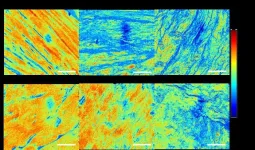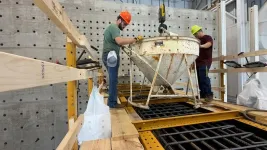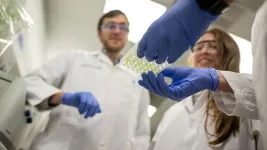(Press-News.org) Tumor cells circulating in the blood are the “germ cells” of breast cancer metastases. They are very rare and could not be propagated in the culture dish until now, which made research into therapy resistance difficult. A team from the German Cancer Research Center (DKFZ), the Heidelberg Stem Cell Institute HI-STEM* and the NCT Heidelberg** has now succeeded for the first time in cultivating stable tumor organoids directly from blood samples of breast cancer patients. Using these mini-tumors, the researchers were able to decipher a molecular signaling pathway that ensures the cancer cells' survival and resistance to therapy. With this knowledge, the team was able to develop an approach to specifically eliminate these tumor cells in lab experiments.
Metastases are the dangerous offshoots of tumors that spread to vital organs such as the liver, lungs or brain and are usually difficult to treat. Even though the prognosis for breast cancer patients has improved significantly in recent decades, metastatic breast cancer still poses a major challenge, as the metastases often only respond temporarily to treatment.
Breast cancer metastases are initiated by cancer cells that detach from the primary tumor and migrate to other organs via the bloodstream. These circulating cancer cells (CTCs) are extremely rare and hide among the billions of blood cells. Andreas Trumpp, Head of a research division at the DKFZ and Director of HI-STEM, had already demonstrated several years ago that only a few of the circulating tumor cells are capable of forming a new metastasis in another organ. These mostly therapy-resistant “germ cells” of metastases are very rare, difficult to isolate and could not be multiplied in the laboratory until now. “This makes it difficult to develop targeted new therapies that directly attack the metastasis-initiating cells. However, if we understand how these cells survive the initial therapy and what drives their resistance, we could tackle the formation of breast cancer metastases at the root and perhaps one day even prevent them,” explains the first author of the paper, Roberto Würth from Trumpp's lab.
Andreas Trumpp's team has succeeded for the first time in multiplying CTCs from blood samples of breast cancer patients and growing them as stable tumor organoids in the culture dish. Until now, this always required a detour, namely the complex and lengthy propagation of CTCs in immunodeficient mice. In order to understand how tumor cells become resistant to therapies, researchers need tumor material from different time points in the course of the disease. In contrast to surgical removal of tissue samples (biopsies), blood samples are simple and can be taken several times.
The three-dimensional and patient-specific mini-tumors can be cultivated from blood samples several times during the course of the disease and are ideally suited for investigating the molecular mechanisms that enable tumors to survive despite therapy. Preclinical tests on the efficacy of already available cancer drugs can also be carried out quickly and on a large scale on organoids in the culture dish.
In the clinical registry trial CATCH (ClinicalTrials.gov ID: NCT05652569) at the NCT Heidelberg, the genetic diversity of patients‘ breast cancer cells is analyzed. Thanks to the successful cultivation of the organoids, Trumpp's interdisciplinary research team, in close collaboration with the experts of the CATCH trial, was able to identify a key signaling pathway that ensures the growth and survival of breast cancer CTCs in the blood. The protein NRG1 (neuregulin 1) acts like a vital “fuel”. It binds to the HER3 receptor on the cancer cells and, together with the HER2 receptor, activates signaling pathways that ensure the growth and survival of the cells. What is also exciting is that even if this fuel runs out or the receptors are blocked by drugs, the cells find new tricks. An alternative signaling pathway, controlled by FGFR1 (fibroblast growth factor receptor 1), steps in and ensures growth and survival.
“With the help of such 'bypasses', tumors react to external influences, for example to targeted therapies against HER2. This is a crucial mechanism in the development of therapy resistance,” explains Roberto Würth. But there are ways out: the researchers used organoids to show that a combined blockade of both signaling pathways (NRG1-HER2/3 and FGFR) can effectively stop the proliferation of tumor cells and induce cell death.
Andreas Trumpp summarizes: “The possibility of cultivating CTCs from the blood of breast cancer patients as tumor organoids in the laboratory at different time points is a decisive breakthrough. This makes it much easier to investigate how tumor cells become resistant to therapies. On this basis, we can develop new treatments that may also specifically kill resistant tumor cells. Another conceivable approach is to adapt existing therapies in such a way that the development of resistance and metastases is reduced or even prevented from the outset. As the organoids are specific to each patient, this method is suitable for identifying or developing customized therapies that are optimally tailored to the respective diseases.” Before the method can be used to treat breast cancer patients, it must first be tested in clinical trials.
*The Heidelberg Institute for Stem Cell Technology and Experimental Medicine (HI-STEM) gGmbH was founded in 2008 as a public-private partnership between the DKFZ and the Dietmar Hopp Foundation
** The National Center for Tumor Diseases (NCT) Heidelberg is a long-term cooperation between the German Cancer Research Center, the University Hospital and the University of Heidelberg.
Roberto Würth, Elisa Donato, Laura L. Michel, Massimo Saini, Lisa Becker, Tasneem Cheytan, Daria Doncevic, Tobias Messmer, Ewgenija Gutjahr, Rebecca Weber, Corinna Klein, Hamed Alborzinia, Umut Yildiz, Vanessa Vogel, Mario Hlevnjak, Polina Kozyulina, Sarah-Jane Neuberth, Paul Schwerd-Kleine, Sevinç Jakab, Nicole Pfarr, Arlou Kristina Angeles, Astrid K. Laut, Darja Karpova, Mattia Falcone, Olaf Hardt, Benjamin Theek, Celina V. Wagner, Mirjam Becker, Sabine Wagner, Martina Haselmayr, Anita Schmitt, Carsten Müller-Tidow, Sabine Riethdorf, Klaus Pantel, Marc Zapatka, Holger Sültmann, Carl Herrmann, Verena Thewes, Peter Lichter, Andreas Schneeweiss, Martin R. Sprick, & Andreas Trumpp: Circulating tumor cell plasticity determines breast cancer therapy resistance via neuregulin 1–HER3 signaling
Nature Cancer 2025, https://doi.org/10.1038/s43018-024-00882-2
END
New approaches against metastatic breast cancer: mini-tumors from circulating cancer cells
2025-01-03
ELSE PRESS RELEASES FROM THIS DATE:
Loneliness linked to higher risk of heart disease and stroke and susceptibility to infection
2025-01-03
Interactions with friends and family may keep us healthy because they boost our immune system and reduce our risk of diseases such as heart disease, stroke and type 2 diabetes, new research suggests.
Researchers from the UK and China drew this conclusion after studying proteins from blood samples taken from over 42,000 adults recruited to the UK Biobank. Their findings are published today in the journal Nature Human Behaviour.
Social relationships play an important role in our wellbeing. Evidence increasingly ...
Some bacteria evolve like clockwork with the seasons
2025-01-03
Like Bill Murray in the movie “Groundhog Day,” bacteria species in a Wisconsin lake are in a kind of endless loop that they can’t seem to shake. Except in this case, it’s more like Groundhog Year.
According to a new study in Nature Microbiology, researchers found that through the course of a year, most individual species of bacteria in Lake Mendota rapidly evolved, apparently in response to dramatically changing seasons. Gene variants would rise and fall over generations, yet hundreds of separate species would return, almost fully, to near copies of what they had been genetically prior to a thousand or so generations of evolutionary pressures. (Individual microbes ...
New imaging technique offers insight into Achilles tendon injury recovery
2025-01-03
Achilles tendon injuries are common but challenging to monitor during recovery due to the limitations of current imaging techniques. Researchers, led by Associate Professor Zeng Nan from the International Graduate School at Shenzhen, Tsinghua University, have applied Mueller matrix polarimetry, a non-invasive imaging method, to more accurately observe and evaluate the healing of Achilles tendon injuries. This technique offers unique insights by capturing the subtle changes in tendon tissue without needing labels or dyes, allowing for more natural tissue characterization.
The study used Mueller ...
Bereavement science researcher provides insights on parasocial grief
2025-01-03
MIAMI, FLORIDA (Jan. 2, 2025) – Many people are surprised by the intensity of their response when a well-known person dies, and their feelings of sadness may last longer than they expect. In fact, that sadness and grief can be intense, and preliminary research suggests that grief after the death of a public figure looks very similar to grief over our personal relationships and can have comparable levels of intensity.
Wendy Lichtenthal, Ph.D., a bereavement science researcher, is available to discuss “parasocial grief” – that which occurs when a celebrity, political ...
New research aims to improve bridge construction in Texas
2025-01-02
A groundbreaking method for bridge construction is set to enhance performance, reduce construction time, and cut costs for future bridges across Texas.
Dr. Kinsey Skillen, assistant professor in the Civil and Environmental Engineering Department at Texas A&M University, was named Principal Investigator (PI) of the Texas Department of Transportation (TxDOT) research project titled “Develop/Refine Design Provisions for Headed and Hooked Reinforcement.”
The 42-month project, which received nearly $1 million in funding, is a joint effort between the Texas Transportation Institute and the University of Texas at San Antonio (UTSA) exploring more efficient methods ...
These bacteria perform a trick that could keep plants healthy
2025-01-02
To stay healthy, plants balance the energy they put into growing with the amount they use to defend against harmful bacteria. The mechanisms behind this equilibrium have largely remained mysterious.
Now, engineers at Princeton have found an answer in an unexpected place: the harmless, or sometimes beneficial, bacteria that cluster around plants’ roots.
In an article published Dec. 24 in the journal Cell Reports, researchers showed that some types of soil bacteria can influence a plant’s ...
Expanding the agenda for more just genomics
2025-01-02
Genomics is being integrated into biomedical research, medicine, and public health at a rapid pace, but the capacities necessary to ensure the fair, global distribution of benefits are lagging. A new special report outlines opportunities to enhance justice in genomics, toward a world in which genomic medicine promotes health equity, protects privacy, and respects the rights and values of individuals and communities.
The report, “Envisioning a More Just Genomics,” is a collaboration between ...
Detecting disease with only a single molecule
2025-01-02
UC Riverside scientists have developed a nanopore-based tool that could help diagnose illnesses much faster and with greater precision than current tests allow, by capturing signals from individual molecules.
Since the molecules scientists want to detect -- generally certain DNA or protein molecules -- are roughly one-billionth of a meter wide, the electrical signals they produce are very small and require specialized detection instruments.
“Right now, you need millions of molecules to detect ...
Robert McKeown recognized for a half century of distinguished service
2025-01-02
NEWPORT NEWS, VA – For nearly half a century, Robert D. “Bob” McKeown has probed nuclear particles and educated rising generations of physicists. Now, the former deputy director for science at the U.S. Department of Energy’s Thomas Jefferson National Accelerator Facility is being honored for his outstanding career contributions with the 2024 American Physical Society’s Division of Nuclear Physics (DNP) Distinguished Service Award.
McKeown is recognized for his work in experimental physics and his extensive leadership in the broader ...
University of Maryland awarded $7.8 million to revolutionize renewable energy for ocean monitoring devices
2025-01-02
University of Maryland researcher Stephanie Lansing received a Phase 1 $7.8M award from Defense Advanced Research Projects Agency (DARPA) to develop and test a biologically fueled energy source to power research and sensing devices throughout the world’s oceans.
There is a vast array of ocean sensing devices that provide critical information for understanding marine environments, monitoring climate change and maintaining national security. Many of these sensors are currently powered by long underwater cables or lithium-ion batteries.
Lansing is leading a large, collaborative effort that will overcome the need for batteries and ship-based or shore-based ...





